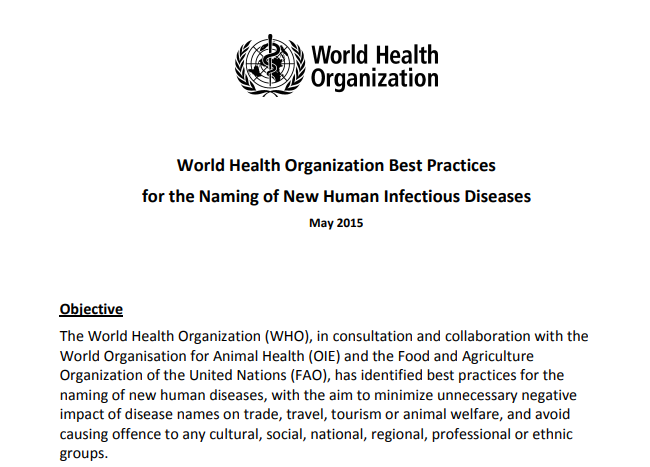2月11日,世界卫生组织总干事谭德塞宣布,将新型冠状病毒感染的肺炎命名为“COVID-19”。

图片来源:世界卫生组织驻华代表处
"We now have a name for the disease and it's COVID-19," WHO chief Tedros Adhanom Ghebreyesus told reporters in Geneva.
在日内瓦,世界卫生组织总干事谭德塞对记者表示:“我们将这个疾病命名为COVID-19。”
这个名字COVID-19来源于corona(冠状)、virus(病毒)以及disease(疾病)三个词,而19则代表这个疾病出现的年份2019年。新冠肺炎疫情是在2019年12月31日上报至世界卫生组织的。
谭德塞指出:
"We had to find a name that did not refer to a geographical location, an animal, an individual or group of people, and which is also pronounceable and related to the disease," the WHO chief said.
我们要取的名字不能指向某个地理位置、某个动物、某个人或群体,同时这个名字要易读,且与该疾病相关。
"Having a name matters to prevent the use of other names that can be inaccurate or stigmatizing. It also gives us a standard format to use for any future coronavirus outbreaks."
正式命名可以阻止其他不准确或者污名化名称的使用,同时,也让我们在今后的冠状病毒疫情命名时有标准可循。
新型冠状病毒名称为SARS-CoV-2
The virus itself has been designated SARS-CoV-2 by the International Committee on Taxonomy of Viruses.
新型冠状病毒的名称则由国际病毒分类委员会指定为SARS-CoV-2。

图片来源:agencies
冠状病毒(coronavirus)是一个病毒大家族,其中包括引起普通感冒的病毒,以及曾经造成重大疫情的:
► 严重急性呼吸综合征(Severe Acute Respiratory Syndrome,SARS)冠状病毒;
► 中东呼吸综合征(Middle East Respiratory Syndrome,MERS)冠状病毒。
此前,世界卫生组织建议使用的临时名称,英文叫“2019-nCoV”。2019指代病毒被发现的年份,后面的nCoV是“新型冠状病毒”英文翻译new/novel coronavirus的缩写。
为什么给病毒起名讲究这么多?
美国约翰斯·霍普金斯健康安全中心高级学者、助理教授克丽丝特尔·沃森(Crystal Watson, senior scholar and assistant professor at the Johns Hopkins Center for Health Security)表示虽然当下焦点都放在了公共卫生应对上,不过病毒命名工作也值得优先处理。
"The naming of a new virus is often quite delayed and the focus until now has been on the public health response, which is understandable."
“给新病毒的命名通常都会滞后许多,而且到目前为止,焦点都放在公共卫生应对上,这是可以理解的。”
"But there are reasons the naming should be a priority."
“但是,病毒命名工作应该优先处理,是有原因的。”
她给出了几点原因:
❶ "The name it has now is not easy to use and the media and the public are using other names for the virus," says Dr Watson.
“目前的病毒名称用起来并不方便,而媒体和公众都在使用病毒的别名。”
❷ "The danger when you don't have an official name is that people start using terms like China Virus, and that can create a backlash against certain populations."
“没有正式名称的危险在于,人们开始使用诸如‘中国病毒’等表述,这会导致人们对部分特定人群产生强烈抵制。”
❸ with social media, unofficial names take hold quickly and are hard to take back, she says.
她说,非官方的名称很容易在社交媒体上迅速流行起来,这很难撤回。
其实,给病毒起名不慎,早已有前车之鉴。
The H1N1 virus in 2009 was dubbed "swine flu". this led Egypt to slaughter all of its pigs, even though it was spread by people, not pigs.
2009年的甲型H1N1流感病毒曾另被称作“猪流感”,结果导致埃及屠宰了境内全部的猪。但其实这种流感病毒是由人传播,而不是猪传播。
正式名称不合适也可能引发各种潜在问题。
世界卫生组织就曾在2015年批评过“中东呼吸综合征” (MERS:Middle East Respiratory Syndrome)这一名称。
命名中含有地区信息,这就可能招致不必要的地域歧视。毕竟病毒只是在这一地区偶然发现的,没人能够证明世界上其他地方就不存在该病毒。
世卫组织在一篇声明中说道:
"We've seen certain disease names provoke a backlash against members of particular religious or ethnic communities, create unjustified barriers to travel, commerce and trade, and trigger needless slaughtering of food animals."
“我们注意到某些疾病的名称煽动起了对特定宗教或是族裔成员的抵制,对旅行、商业和贸易造成不正当的障碍,并且引发了对食用动物不必要的屠杀。”
2015年,世卫组织发布了命名新型人类传染病的指导原则,要求名称中不能包含以下信息:

世卫组织文件截图
◆ 地理位置
geographical locations
◆ 人名
people's names
◆ 动物或食物的名字
the name of an animal or a kind of food
◆ 指向特定文化或行业
references to a particular culture or industry
【相关词汇】
世界卫生组织 World Health Organization
国际病毒分类委员会 International Committee on Taxonomy of Viruses
人类传染病 human infectious disease
核酸检测 nucleic acid test
参考来源:BBC News,世界卫生组织官网,新华网,中国日报双语新闻







